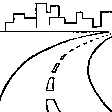



A 16 cubic metre concrete tank situated in the shadow of the house constructed to retain rainwater that collects in the roof guttering.
Purpose of the Technology: The purpose of the tank is to retain water to be used for drinking, sanitation and irrigation during the hot and dry summer months. The retained water allows for the irrigation of kitchen garden plots and more diverse crops, and hence should improve the livelihoods of households involved.
Establishment / maintenance activities and inputs: There are three main elements to the construction of the rainwater harvesting system. The first is the construction of a metal gutter on wooden supports around the perimeter of the roof; second, the construction of a concrete pool in the shadow of the house; and finally the provision of a connection pipe between the gutter and the pool. The pool needs to be cleaned periodically to prevent contamination and build up of algae around the edge the pool.
Natural / human environment: During the Soviet period the water supply for the village was supplied through a concrete storage tank located at the foot of the hills above the village. After the collapse of the Soviet Union the concrete tank and its associated infrastructure fell into disrepair. As a result the inhabitants were faced with water shortages, especially during the hot dry summers. In response to this issue the residents invested time, finance and resources into constructing rainwater collection systems.

Location: Rudaki, Boshkengash, Tajikistan, Tajikistan
No. of Technology sites analysed:
Spread of the Technology: applied at specific points/ concentrated on a small area
In a permanently protected area?:
Date of implementation: 10-50 years ago
Type of introduction








| Specify input | Unit | Quantity | Costs per Unit (Somoni) | Total costs per input (Somoni) | % of costs borne by land users |
| Labour | |||||
| Construction of concrete tank and guttering | Persons/day | 20.0 | 22.5 | 450.0 | 100.0 |
| Equipment | |||||
| Tools | pieces | 6.0 | 11.1666666 | 67.0 | 100.0 |
| Construction material | |||||
| Concrete sand, stone | tons | 2.0 | 337.5 | 675.0 | 100.0 |
| Metal guttering | tons | 0.5 | 900.0 | 450.0 | 100.0 |
| Wood | tons | 0.5 | 240.0 | 120.0 | 100.0 |
| Plastic pipes | pieces | 1.0 | 10.0 | 10.0 | 100.0 |
| Total costs for establishment of the Technology | 1'772.0 | ||||
| Total costs for establishment of the Technology in USD | 1'772.0 | ||||
| Specify input | Unit | Quantity | Costs per Unit (Somoni) | Total costs per input (Somoni) | % of costs borne by land users |
| Labour | |||||
| Cleaning | Person/day | 1.0 | 25.0 | 25.0 | 100.0 |
| Total costs for maintenance of the Technology | 25.0 | ||||
| Total costs for maintenance of the Technology in USD | 25.0 | ||||
Due to access to water in the summer months
From the increased number of fruit trees.
Quantity before SLM: None
Quantity after SLM: 16 cub m
Readily available especially in the summer months.
Quantity before SLM: None
Quantity after SLM: 16 cub m
Dramatically increased, in the summer months.
Quantity before SLM: None
Quantity after SLM: 16 cub m
During the drought periods.
In some households water had to be purchased.
No collection of water from distant sources.
Initial outlay in the region of $400
Able to grow more and of a better quality.
Previously residents had to wait at water points.
Constant access to water dramatically improves sanitation levels in the village.
Permanent access to water has dramatically improved the sanitation and hygiene levels, and increased crop quality and diversification. It has also improved the quality of and access to drinking water, and therefore has significant health benefits.
Quantity before SLM: None
Quantity after SLM: 16 cub m
Readily available water supply.
Quantity before SLM: None
Quantity after SLM: 16 cub m
Quantity before SLM: None
Quantity after SLM: 16 cub m
The technology concentrates on harvesting water.
Tank is built in the shadow of the house.
Able to grow crops at different times of the year.